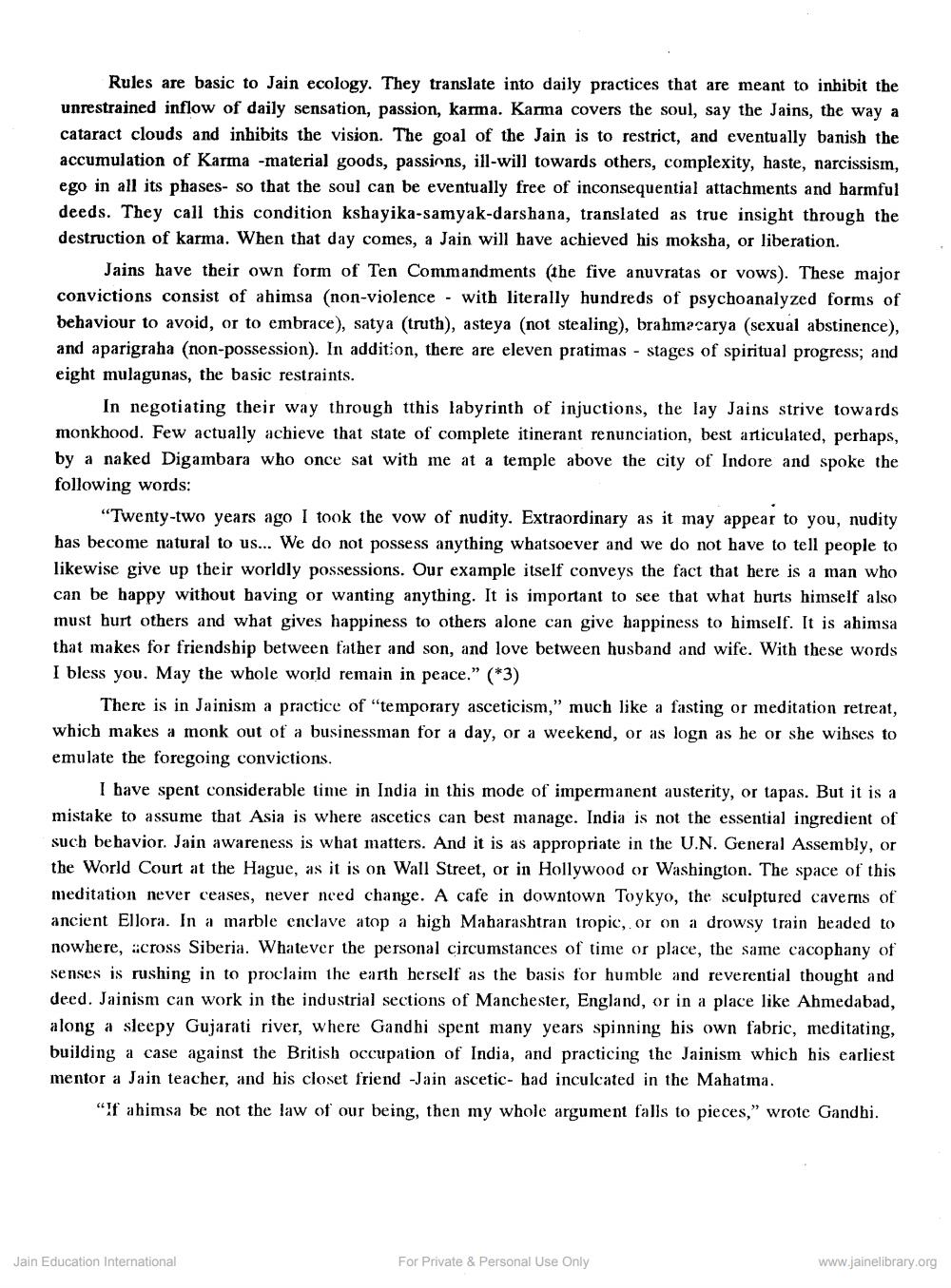________________
Rules are basic to Jain ecology. They translate into daily practices that are meant to inhibit the unrestrained inflow of daily sensation, passion, karma. Karma covers the soul, say the Jains, the way a cataract clouds and inbibits the vision. The goal of the Jain is to restrict, and eventually banish the accumulation of Karma -material goods, passinns, ill-will towards others, complexity, haste, narcissism, ego in all its phases- so that the soul can be eventually free of inconsequential attachments and harmful deeds. They call this condition kshayika-samyak-darshana, translated as true insight through the destruction of karma. When that day comes, a Jain will have achieved his moksha, or liberation.
Jains have their own form of Ten Commandments the five anuvratas or vows). These major convictions consist of ahimsa (non-violence - with literally hundreds of psychoanalyzed forms of behaviour to avoid, or to embrace), satya (truth), asteya (not stealing), brahmacarya (sexual abstinence), and aparigraha (non-possession). In addition, there are eleven pratimas - stages of spiritual progress; and eight mulagunas, the basic restraints.
In negotiating their way through tthis labyrinth of injuctions, the lay Jains strive towards monkhood. Few actually achieve that state of complete itinerant renunciation, best articulated, perhaps, by a naked Digambara who once sat with me at a temple above the city of Indore and spoke the following words:
“Twenty-two years ago I took the vow of nudity. Extraordinary as it may appear to you, nudity has become natural to us... We do not possess anything whatsoever and we do not have to tell people to likewise give up their worldly possessions. Our example itself conveys the fact that here is a man who can be happy without having or wanting anything. It is important to see that what hurts himself also must hurt others and what gives happiness to others alone can give happiness to himself. It is ahimsa that makes for friendship between father and son, and love between husband and wife. With these words I bless you. May the whole world remain in peace.” (*3)
There is in Jainism a practice of "temporary asceticism," much like a fasting or meditation retreat, which makes a monk out of a businessman for a day, or a weekend, or as logn as he or she wihses to emulate the foregoing convictions.
I have spent considerable time in India in this mode of impermanent austerity, or tapas. But it is a mistake to assume that Asia is where ascetics can best manage. India is not the essential ingredient of such behavior. Jain awareness is what matters. And it is as appropriate in the U.N. General Assembly, or the World Court at the Hague, as it is on Wall Street, or in Hollywood or Washington. The space of this meditation never ceases, never need change. A cafe in downtown Toykyo, the sculptured cavems of ancient Ellora. In a marble enclave atop a high Maharashtran tropic, or on a drowsy train headed to nowhere, across Siberia. Whatever the personal circumstances of time or place, the same cacophany of senses is rushing in to proclaim the earth herself as the basis for humble and reverential thought and deed. Jainism can work in the industrial sections of Manchester, England, or in a place like Ahmedabad, along a sleepy Gujarati river, where Gandhi spent many years spinning his own fabric, meditating, building a case against the British occupation of India, and practicing the Jainism which his earliest mentor a Jain teacher, and his closet friend -Jain ascetic- had inculcated in the Mahatma.
"! ahimsa be not the law of our being, then my whole argument falls to pieces," wrote Gandhi.
Jain Education International
For Private & Personal Use Only
www.jainelibrary.org




